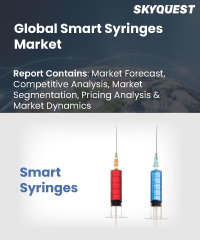
Report ID: SQMIG35A2214

Report ID:
SQMIG35A2214 |
Region:
Global |
Published Date: July, 2024
Pages:
242
|
Tables:
117 |
Figures:
77
Smart Syringes Market Driver
As the prevalence of targeted diseases has increased, vaccination programs against targeted diseases have increased in various regions of the world. Also, the need to reduce hospital-acquired infections will drive the demand for smart syringes during the projection period. Smart syringes are in high demand due to the growing elderly population worldwide.
Asia-Pacific and Latin American market growth are attractive for smart syringes. Due to the increase in needle stick injuries and the spread of HIV and hepatitis, the use of traditional syringes has stopped. Also, the adoption of smart syringes is rapidly increasing due to the growing desire for safer injection procedures.
The increase in needle stick injuries has significantly impacted the smart syringe market. Because needle stick injuries are the leading cause of blood-borne infections among healthcare workers, the impact of this factor is expected to increase during the forecast period. These injuries can spread human immunodeficiency virus (HIV), hepatitis B, and hepatitis C. Other diseases can be blast mycosis, brucellosis, cryptococcosis, diphtheria, cutaneous gonorrhoea, herpes, malaria, mycobacteriosis, sporotrichosis, syphilis, and tuberculosis, are transmitted through needle stick injuries.
Smart Syringes Market Restraint
Smart syringes are more expensive than standard syringes, making their worldwide implementation challenging. Some versions cost the same as single-use syringes. Others can cost up to five times more than others, depending on the technological advancement of the security systems, making them unaffordable in some low-and middle-income countries. Also, the high capital expenditure required to develop and maintain some safety syringes, as well as price fluctuations due to technologically improved syringes, hamper the market growth.
Our industry expert will work with you to provide you with customized data in a short amount of time.
REQUEST FREE CUSTOMIZATIONWant to customize this report? This report can be personalized according to your needs. Our analysts and industry experts will work directly with you to understand your requirements and provide you with customized data in a short amount of time. We offer $1000 worth of FREE customization at the time of purchase.

Report ID: SQMIG35A2214